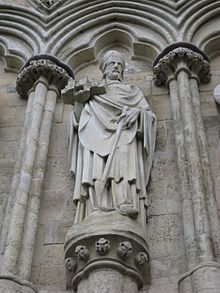Customary (liturgy)

A customary is a Christian
Description
Customaries are generally
Customaries simultaneously developed to contain the community customs and daily organization of a religious order, and often individual customaries would contain material both liturgical and regulatory.
Academic appraisal
Medieval customaries have received recent academic appreciation, particularly from historians of monasticism, who appreciate the detail available in descriptions of the ceremonies and their interactions with local infrastructure. Since the first half of the 20th century, the study of customaries has evolved into its own discipline. Among the notable publications that led to this renewed interest in customaries are Consuetudines monasticae, produced by Bruno Albers from 1905 to 1912, and Corpus Consuetudinum Monasticarum, a continuing series first published in 1963 with Kassius Hallinger as editor that is considered the best source on
History

As bishops had increasing responsibilities, they were increasingly absent from their cathedrals. This necessitated the creation of books of rules for use by the clergy left in charge of cathedrals' practices. The consuetudinary contained these regulations. It also contains the general ceremony and assigned roles for rituals in accordance with rules of precedence and local customs.[12]: 16 In monastic communities, the consuetudinary could also introduce new rules and practices; among the earliest requirements for mental prayer was contained in a 12th-century Carthusian consuetudinary.[13]
In cases like the Sarum Use at Salisbury Cathedral, the most important portions of the consuetudinary were condensed into what Frere distinguished as the customary.[14] In the case of Salisbury, the consuetudinary is dated to roughly 1210–though with a range of 1173 to 1220[5]: 368 –when Richard Poore was the cathedral's dean and formed the most comprehensive code of customs of the Sarum Use. The Sarum ordinal was a similar book for use by the choir and contained greater detail on certain liturgical actions only addressed more generally by the consuetudinary.[15] The Sarum consuetudinary made reference to the ordinal and relied on it for complete celebration of a given ritual.[16] Surviving manuscripts of the Sarum ordinal and customary dating from before 1279 and originating from outside cathedral feature appended notes that suggest the practices of Salisbury Cathedral had changed from Poore's time as dean.[17]
Gradually, the texts needed for the celebration of the
Customaries were revived in response to the variety of worship patterns that developed within Anglicanism during the 19th century. Editions of the Book of Common Prayer, such as 1662 prayer book in the Church of England, offered few explicit ceremonial directions. As such, communities such as Chichester Cathedral assembled and published customaries for not only internal usage but reference by other church communities.[18] Customaries also continue in Catholic monastic use, where monasteries such as those of the Benedictine Swiss-American and American-Cassinese Congregations are required by congregational constitutions to create their own customaries.[19][20]
See also
References
- ^ a b This article incorporates text from a publication now in the public domain: Chisholm, Hugh, ed. (1911). "Consuetudinary". Encyclopædia Britannica. Vol. 7 (11th ed.). Cambridge University Press. p. 18.
- ^ Custom Book of Cloistered Dominican Sisters of the Perpetual Rosary (Revised ed.). Dominican Nuns of the Perpetual Rosary. 1950 – via Archive.org, Catholic Theological Union.
- ^ Customary Usage for the Chapel of the Apostles (PDF). Sewanee, TN: Sewanee: The University of the South. 19 May 2005. Retrieved 18 November 2022.
- ^ a b c Strayer, Joseph R., ed. (1984). Dictionary of the Middle Ages. Vol. 4. New York City: Charles Scribner's Sons. p. 68.
- ^ ISBN 9781139482929 – via Google Books.
- ^ ISBN 9780198162797.
- ^ ISBN 9780916134716.
- ^ ISBN 0-19-211655-X.
- ^ "Glossary of Monastic Terms". Monastic Wales. University of Wales Trinity Saint David, University of Lleida. Retrieved 23 November 2022.
- ^ ISBN 978-0-19-513886-3.
- ^ a b Stamler, Ábel (2021). "Index liturgicus ad Corpus Consuetudinum Monasticarum". Argumentum Kiadó - Elte BTK Vallástudományi Központ Liturgiatörténeti Kutatócsoport. Budapest: MTA–ELTE Lendület Research Group of Liturgical History, Argumentum Publishing House – via academic.edu.
- ^ a b Procter, Francis; Frere, Walter Howard. A New History of The Book of Common Prayer, With a Rationale of Its Offices. London: Macmillan and Co. Limited.
- ^ Wynne, John (1911). "Prayer". The Catholic Encyclopedia. Vol. 12. New York City: Robert Appleton Company – via NewAdvent.
- ^ Pullan, Leighton (1901). Newbolt, W.C.E.; Stone, Darwell (eds.). The History of the Book of Common Prayer. The Oxford of Practical Theology (3rd ed.). London: Longmans, Green, and Co. p. 42.
- ^ Evans, Sydney (1985). Salisbury Cathedral: A Reflective Guide. Salisbury, Wiltshire: Michael Russel Ltd. p. 47-48.
- ^ Frere, Walter Howard (1901). The Use of Sarum. Vol. II. The Ordinal and Tonal. London: Cambridge University Press. p. vii.
- ^ ISBN 9781108654005.
- Society for the Promotion of Christian Knowledge. p. xi.
- Elkhorn, NE: Mount Michael Abbey. 29 February 2016. p. 2. Retrieved 23 November 2022.
- ^ Monastic Customary of Assumption Abbey (PDF). Richardton, ND: Assumption Abbey. August 2013. p. 2. Retrieved 23 November 2022.
Further reading
- B. Albers, Consuetudines monasticae, Volumes 1-2, 1900–1905. A collection of Benedictine consuetudinaries. In Latin.
- E. Martène, De antiquis Ecclesiæ ritibus. A collection of the liturgical bookz of Abbey of Saint-Victor, Paris, including their customary. In Latin.
